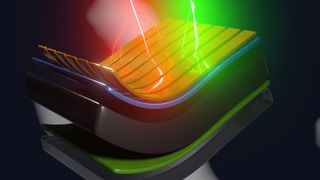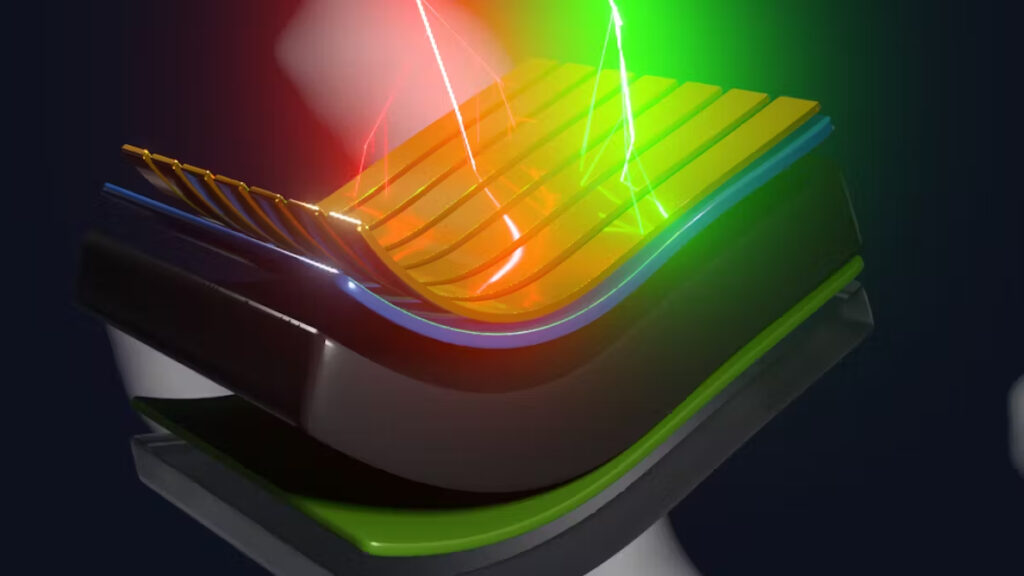
A schematic shows a perovskite solar cell being irradiated with a damaging (red) and a healing (green) proton beam.
(Image credit: Ahmad Kirmani)
The space environment is harsh and full of extreme radiation. Scientists designing spacecraft and satellites need materials that can withstand these conditions.
In a paper published in January 2024, my team of materials researchers demonstrated that a next-generation semiconductor material called metal-halide perovskite can actually recover and heal itself from radiation damage.
Metal-halide perovskites are a class of materials discovered in 1839 that are found abundantly in Earth’s crust. They absorb sunlight and efficiently convert it into electricity, making them a potentially good fit for space-based solar panels that can power satellites or future space habitats.
Researchers make perovskites in the form of inks, then coat the inks onto glass plates or plastic, creating thin, filmlike devices that are lightweight and flexible.
Surprisingly, these thin-film solar cells perform as well as conventional silicon solar cells in laboratory demonstrations, even though they are almost 100 times thinner than traditional solar cells.
Related: Space-based solar power may be one step closer to reality, thanks to this key test (video)
But these films can degrade if they’re exposed to moisture or oxygen. Researchers and industry are currently working on addressing these stability concerns for terrestrial deployment.
Breaking space news, the latest updates on rocket launches, skywatching events and more!
The mysterious rays shooting at us from space – YouTube
Watch On
To test how they might hold up in space, my team developed a radiation experiment. We exposed perovskite solar cells to protons at both low and high energies and found a unique, new property.
The high-energy protons healed the damage caused by the low-energy protons, allowing the device to recover and continue doing its job. The conventional semiconductors used for space electronics do not show this healing.
My team was surprised by this finding. How can a material that degrades when exposed to oxygen and moisture not only resist the harsh radiation of space but also self-heal in an environment that destroys conventional silicon semiconductors?
In our paper, we started to unravel this mystery.
Why it matters
Scientists predict that in the next 10 years, satellite launches into near-Earth orbit will increase exponentially, and space agencies such as NASA aim to establish bases on the Moon.
Materials that can tolerate extreme radiation and self-heal would change the game.
Researchers estimate that deploying just a few pounds of perovskite materials into space could generate up to 10,000,000 watts of power. It currently costs about US$4,000 per kilogram ($1,818 per pound) to launch materials into space, so efficient materials are important.
What still isn’t known
Our findings shed light on a remarkable aspect of perovskites – their tolerance to damage and defects. Perovskite crystals are a type of soft material, which means that their atoms can move into different states that scientists call vibrational modes.
Atoms in perovskites are normally arranged in a lattice formation. But radiation can knock the atoms out of position, damaging the material. The vibrations might help reposition the atoms back into place, but we’re still not sure exactly how this process works.
What’s next?
Our findings suggest that soft materials might be uniquely helpful in extreme environments, including space.
But radiation isn’t the only stress that materials have to weather in space. Scientists don’t yet know how perovskites will fare when exposed to vacuum conditions and extreme temperature variations, along with radiation, all at once. Temperature could play a role in the healing behavior my team saw, but we’ll need to conduct more research to determine how.
These results tell us that soft materials could help scientists develop technology that works well in extreme environments. Future research could dive deeper into how the vibrations in these materials relate to any self-healing properties.
The Research Brief is a short take on interesting academic work.
Join our Space Forums to keep talking space on the latest missions, night sky and more! And if you have a news tip, correction or comment, let us know at: community@space.com.
I am an Assistant Professor of Chemistry & Materials Science at the Rochester Institute of Technology (RIT).
In a career spanning 10+ years, I have researched next-generation solution-processed semiconductor electronics based on colloidal nanocrystals, metal-oxides, and metal-halide perovskite semiconductors. This body of research has so far resulted in over 55 research articles with lead works published in high-impact journals including Nature Energy, Nature Communications, Joule, Advanced Materials, & ACS Energy Letters, besides multiple contributed and invited talks. During my postdoctoral tenure at the National Renewable Energy Laboratory (NREL), I have advanced perovskite optoelectronics for aerospace applications.
My research has drawn attention to the interfacial and microstructural complexity in printed electronics, and the need to understand it for enabling the lab-to-fab transition.
>>> Read full article>>>
Copyright for syndicated content belongs to the linked Source : Space.com – https://www.space.com/space-radiation-satellite-damage-averted-with-next-generation-self-healing-material
